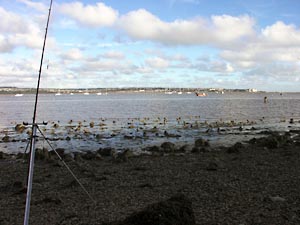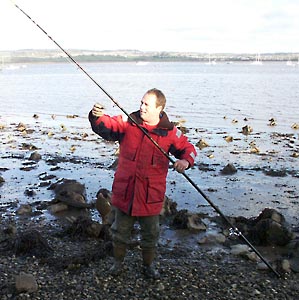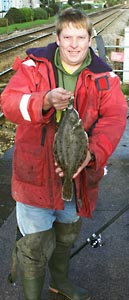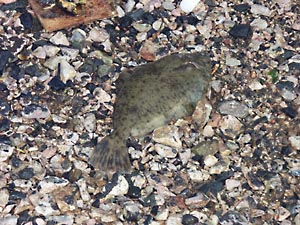 |
||||||||
|
fishing Dartmouth sea angling Devon uk charter boat shore plaice turbot bass river dart RIVER EXE FLOUNDER FROM SHORE |
||||||||
|
We wanted to fish as the Paignton Club was holding a members' competition for named species, which had already been cancelled on three occasions and it had been decided that the competition would go ahead on the chosen day, despite the weather. Tim Bird, Dean Corbett and I amassed a good supply of fresh Devon peeler crab and elected to fish the River Exe for Flounder.
Our preferred tackle consisted of a 13 foot beachcaster rod, equipped with Abu 6500 series multiplier reel and 15 lb mono line, with 50 lb class shock leader. At many venues a far lighter rod with a small fixed spool reel will suffice, but on the Exe, you need to cast quite a long way to reach the fish near the main channels as the tide recedes. We decided to use simple single hook terminal rigs. The main line passed through a sliding swivel link, followed by a single bead and then a small but strong swivel. From the other end of the swivel we attached about a metre of 15 lb trace, followed by a size 1/0 long shank wire "Aberdeen" pattern hook. A 5 ounce gripper lead was fastened to the sliding swivel link.
On one of his rods, Tim fished a modified version of this rig, which had a separate 2nd flying trace in addition to the main trace. He had also elected to put some small brightly coloured beads and sequins directly above his hook. It was the first time Dean and I had fished the Exe from shore, although Tim is a regular "Flounder Bounder" and knows it well. We decided on a spot about a mile upstream from the mouth of the Estuary, just below the railway line which hugs the west shore. The water was swollen by recent heavy rainfall and was well coloured by mud to a shade of "Thick brown Windsor soup", which made it appear reminiscent of the Bristol Channel. There was lots of weed in the water, dislodged by recent storms, which made fishing very difficult as it grabbed the spikes on our weights and cloaked our baited hooks. We found it necessary to retrieve and check our terminal rigs every 10 minutes or so, just to clear the accumulated weed from the line. The beach consisted of thick dark cloying mud over a layer of large sharp pebbles, which apparently gives way to a sandy bottom further out towards the main channel. Close inshore are lines of jealously guarded "Peeler Crab pots" which visiting anglers should never touch without a very good reason. Amongst these, I also saw galvanised wire pouches containing Oysters which are also off limits for similar reasons. You can easily snag your terminal tackle on these obstructions if you are not very careful when retrieving your rig. The favoured bait for Flounder is fresh peeler crab whipped onto the shank of the hook with bait elastic, making certain you leave the hook point exposed, otherwise the fish will be able to spit out your bait when it feels the resistance of the weight. Bites were clearly discernable, with the identifiable "tap tap" of the rod tip, so distinctive as that of a flat fish. The technique is to watch the rod tip after an initial bite for a second enquiry, to be certain the fish is still there. Now is the moment to pick up the rod and feel for the continuing bite. If the fish is still there, you just wind down into the fish to cleanly set your hook against the resistance of the weight.
We fished throughout the day into the failing light of dusk. These fascinating and aggressive small flatfish are great fun to catch. They are natural predators, feeding hungrily on worm and small crustaceans as they blend so easily into their chosen background on the sea bed.
As daylight dimmed into winter evening, the Flounder continued to bite in what were particularly difficult conditions. Alas, our fishing started to become disrupted by the bites of small Silver Eels too, so we packed up and headed back to the Paignton Club. Although Tim caught 3 and Dean caught 2 flounders, none were of sufficient size to warrant taking back for the weigh-in. They were all released alive without delay, to fight again another day. The Paignton Club members' competition that day was won by a Flounder caught from an estuary in deepest Cornwall by Colin Wherlock, with a fish of 2 lbs 5 ozs 14 Dr. That is a fish of 94.688% of NFSA specimen weight. Nice one Colin! Now where is that map of Cornwall......mmmmm! |



